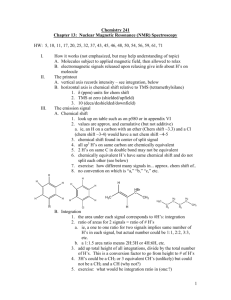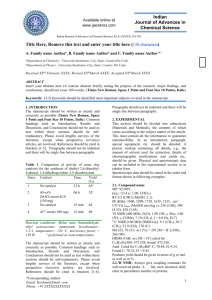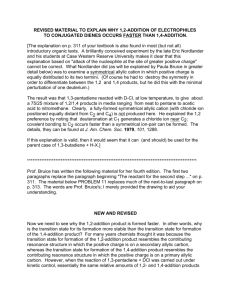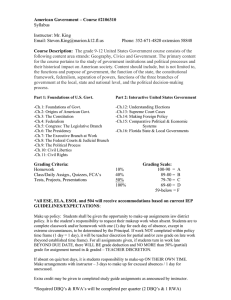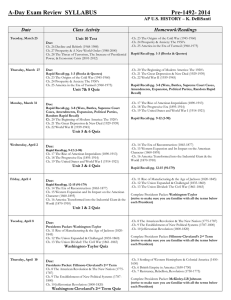POLA_24331_sm_suppinfo
advertisement
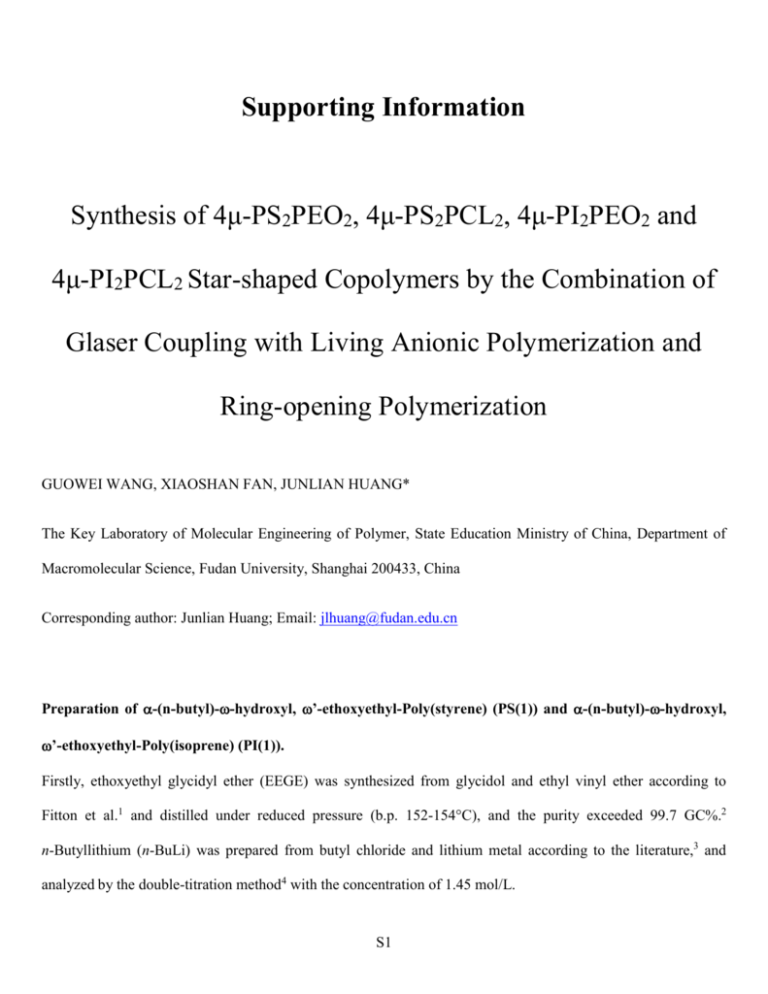
Supporting Information Synthesis of 4μ-PS2PEO2, 4μ-PS2PCL2, 4μ-PI2PEO2 and 4μ-PI2PCL2 Star-shaped Copolymers by the Combination of Glaser Coupling with Living Anionic Polymerization and Ring-opening Polymerization GUOWEI WANG, XIAOSHAN FAN, JUNLIAN HUANG* The Key Laboratory of Molecular Engineering of Polymer, State Education Ministry of China, Department of Macromolecular Science, Fudan University, Shanghai 200433, China Corresponding author: Junlian Huang; Email: jlhuang@fudan.edu.cn Preparation of -(n-butyl)--hydroxyl, ’-ethoxyethyl-Poly(styrene) (PS(1)) and -(n-butyl)--hydroxyl, ’-ethoxyethyl-Poly(isoprene) (PI(1)). Firstly, ethoxyethyl glycidyl ether (EEGE) was synthesized from glycidol and ethyl vinyl ether according to Fitton et al.1 and distilled under reduced pressure (b.p. 152-154°C), and the purity exceeded 99.7 GC%.2 n-Butyllithium (n-BuLi) was prepared from butyl chloride and lithium metal according to the literature,3 and analyzed by the double-titration method4 with the concentration of 1.45 mol/L. S1 The anionic polymerization of styrene or isoprene were carried out according to the literature under the N2 atmosphere,4 where the gas-tight rubber tube was used to seal the reactor and syringe was used to introduce the reagents. Using the preparation of PS(1) as an example: St (30.00 mL), cyclohexane (210.00 mL) and THF (4.00 mL) were charged into a 500 mL dried ampoule under N2 atmosphere, then the n-Bu-Li+ solution (3.77 mL, 5.467 mmol) was injected by a syringe under magnetic stirring. The reaction was kept at room temperature for 8.0 h, then the mixture of EEGE (3.00 mL, 20.55 mmol) and THF (4.00 mL) was added promptly and the system was stirred for another 8.0 h before the termination by CH3OH. After the solvents was evaporated, the product was purified twice by dissolution/precipitation with THF/CH3OH and the obtained white powder of functionalized polystyrene (PS(1)) was dried under vacuum at 45°C for 24.0 h with a constant weight of 27.1636 g and a 99.61% yield. 1H NMR (CDCl3) δ ppm of PS(1): 0.80(CH3CH2-), 1.13(CH3CH2O-), 1.22(-CH(CH3)-), 1.26-2.01(m, 3H, aliphatic main chain -CH2CH- of PS), 3.09-3.43(m, CH3CH2O-, -CH(OH)CH2O-), 3.52(-CH(OH)-), 4.65-4.76 (-OCH(CH3)O-), 6.30-7.30(m, 5H, aromatic –C6H5 of PS chain). SEC: Mn(SEC)=4,900 g/mol, PDI=1.03. FT-IR (cm-1): 1600, 1582, 1492, 1452(aromatic -C-C-). The molecular weight of PS(1) (Mn(NMR,PS(1))=5,000 g/mol ) was calculated according to 1H NMR spectrum (Figure 2) and Formula S1: M n(NMR, PS(1)) Ag 5 Ah ,i ,l 6 104 57 147 ( S1) Where Ag and Ah,i,j were the integral area of the aromatic protons (-C6H5) at 6.30-7.30 ppm (f) on PS min chain and the characteristic methylenene group protons (-CH2-) at 3.60 ppm (a) of the capping agent, respectively. The values of 104 and 57 were the molecular weight of St unit and the mass of the α end initiator residue butyl group(-C4H9). The value of 147 was the sum between the mass of capping molecule EEGE (C7H14O3) and that of a proton(-H). S2 Similarly, the functionalized polyisoprene (PI(1)) was also prepared using the above polymerization procedure. 1H NMR (CDCl3) δ ppm of PI(2): 0.80 (CH3CH2-), 1.13(CH3CH2O-), 1.22 (m, -CH(CH3)-), 1.26-2.25 (m, -C(CH3)-and aliphatic main chain -CH2CH- of PI), 1.86 (m, -C(CH3)=CH-, -C(CH3)=CH2), 3.09-3.43 (m, CH3CH2O-, -CH(OH)CH2O-), 3.52 (-CH(OH)-), 4.65-4.76 (-OCH(CH3)O-), 4.63-4.69 (-(CH3)C=CH2 of 3, 4-addition), 4.95 (-CH=CH2 of 1,2-addition), 5.08 (-CH=C(CH3)- of 1,4-addition), 5.70 (-CH=CH2 of 1,2-addition). SEC: Mn(SEC)=4,600 g/mol, PDI=1.05. FT-IR (cm-1): 3070(=C-H), 1642(-C=C-), 886(=CH2). According to the 1H NMR spectrum (Figure 2), the percentage content of 1,2-Addition (C1,2-Addition), 3,4-Addition (C3,4-Addition) and 1,4-Addition (C1,4-Addition) on isoprene units could be determined by using Formula S2 and the molecular weight of PI(1) (Mn(NMR,PI(1))=4,800 g/mol ) was calculated by using the Formula S3: C1,2-Addition :C3,4-Addition: C1,4-Addition A k : Mn(NMR, PI(1)) Ak Ar , s ,v 6 Ah :(A l ,o -2A k ) 2 C1,2 Addition 68 57 147 ( S 2) ( S 3) Where Ao, Ak, Ah and Ar,s,v were the integral area of the methine protons (-CH=C(CH3)-) at 5.08ppm (o), methine protons (-CH=CH2) at 5.70ppm (k), methylene protons (-(CH3)C=CH2) at 4.63-4.69ppm and methylene protons (-CH2-) at 3.60ppm, respectively. The value of 68 was the molecular weight of isoprene unit. Preparation of -(n-butyl)--propargyl, ’-ethoxyethyl-Poly(styrene) (PS(2)) and Preparation of -(n-butyl)--propargyl, ’-ethoxyethyl-Poly(isoprene) (PI(2)). Into a 500 mL dried ampoule, 26.0201g dried PS(1) (Mn(NMR)(1)=5,000 g/mol, 5.204 mmol) and 270 mL THF were added. Then, the system was charged with N2 and titrated by DPMK solution till to the solution changed into reddish-brown. After the ampoule was placed into ice bath, propargyl bromide (3.91 mL, 6.145g, 52.04 S3 mmol) was added dropwise during 2.0 h and the reaction was continued for 24.0 h at room temperature. The PS(2) was achieved by separation of the formed salts and then purified twice by dissolution/precipitation with THF/CH3OH, and dried under vacuum at 45°C for 12.0 h till to a constant weight (25.6298 g, 98.50% yield). 1H NMR (CDCl3) δ (ppm): 0.80(CH3CH2-), 1.13(CH3CH2O-), 1.22(m, -CH(CH3)-), 3.09-3.59(m, CH3CH2O-, -CH(O-)CH2O-), 3.84-4.18 (-OCH2C≡CH), 4.65-4.76 (-OCH(CH3)O-). FT-IR (cm-1): 3300(-C≡CH). The efficiency of transformation of hydroxyl groups into alkyne groups (E.F.PS(2)=99.52%) was calculated according to 1H NMR spectrum (Figure 2) and Formula S4: E.F.PS(2) = An 2 x100% Ah,i,l 6 (S4) Where An were the integral area of methylene group protons (-OCH2C≡CH) at 3.84-4.18 ppm(n). Similarly, the functionalized polyisoprene (PI(2)) was also prepared using the above modification procedure. 1H NMR (CDCl3) δ ppm of PI(2): 0.80 (CH3CH2-), 1.13(CH3CH2O-), 1.22 (m, -CH(CH3)-), 3.09-3.59 (m, CH3CH2O-, -CH(O-)CH2O-), 3.84-4.18 (-OCH2C≡CH), 4.65-4.76 (-OCH(CH3)O-). FT-IR (cm-1): 3300(-C≡CH), 3070(=C-H), 1642(-C=C-), 886(=CH2). The efficiency of transformation of hydroxyl groups into alkyne groups (E.F.PI(2)=99.70%) was calculated according to 1H NMR spectrum (Figure 2) and Formula S5: E.F.PI(2) = Ax 2 x100% A r,s,v 6 (S5) Where Ax was the integral area of methylene group protons (-OCH2C≡CH) at 3.84-4.18 ppm(n). S4 Figure S1. The FT-IR spectra of 4μ-PS2PEO2 and 4μ-PS2PCL2. Figure S2. The FT-IR spectra of 4μ-PI2PEO2 and 4μ-PI2PCL2. S5 REFERENCES AND NOTES 1. Fitton, A. O.; Hill, J.; Jane, D. E.; Millar, R. Synthesis 1987, 1140-1142. 2. Li, Z. Y.; Li, P. P.; Huang, J. J Polym Sci, Part A: Polym Chem 2006, 44, 4361-4371. 3. Wei, J.; Huang, J. Macromolecules, 2005, 38, 1107-1113. 4. Gilman, H.; Haubein, A. H. J Am Chem Soc 1944, 66, 1515-1516. S6





